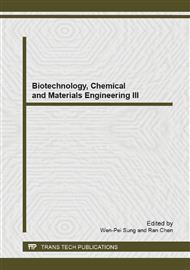p.117
p.121
p.125
p.129
p.134
p.140
p.144
p.148
p.154
Separation of Methyl Propionate-Methanol-Water by Salting-Out Extraction
Abstract:
In order to reduce the energy consumption for the separation of methyl propionate-methanol-water system, the application of salting-out extraction was studied. The main functional mechanism of salting-out extraction was that the salt ions form complex with the methanol molecules and intermolecular hydrogen bonds were formed between the moleculed of inorganic salts and water. The results of gas chromatography showed that adding salts can significantly decrease the mutual solubility of the components in the system mentioned above. The results showed that the optimum operation parameters were as follows: the saturated MgCl2 was selected as the best solvent, solvent ratio (VF/VS) was 1:2.5, extraction temperature was 20 °C, stirring rate was 300r/min, stirring time was 20min, and settling time was 20min. Under the optimized parameters, the mass fraction of methyl propionate exceeded 99.33% and the yield was 90.19% through the three-stage of cross-current extraction.
Info:
Periodical:
Pages:
134-139
Citation:
Online since:
January 2014
Authors:
Keywords:
Price:
Сopyright:
© 2014 Trans Tech Publications Ltd. All Rights Reserved
Share:
Citation:


